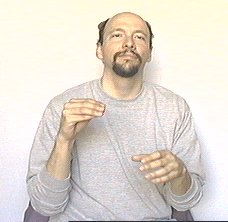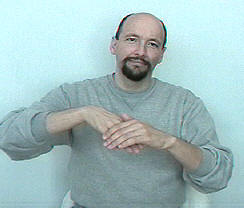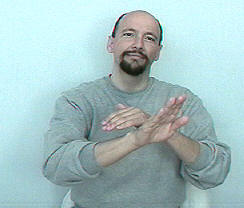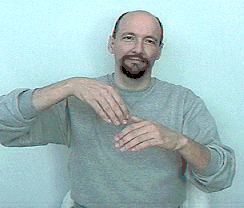

Note: This sign can be used to mean "inside" by doing the movement twice but using a smaller motion the second time.
IN:


Note: This sign can be used to mean "inside" by doing the movement twice but
using a smaller motion the second time.
https://youtu.be/YirRi12-zWo
There are many, many (virtually limitless) sentences that could use the
English word "in" but not use the ASL sign "IN."
Some examples:
back in 1979... = PAST 1979
in fact, ... = TRUE or TRUE-BIZ
in this video = THIS VIDEO [CAN SEE / HAVE / SHOW / INCLUDE ...]
use consistent spacing in your document... = 2-handed-SAME-(depict spacing)
got caught up in watching the = FASCINATED
standing in front of me = CL1-depiction or CL:V-depiction
clasped in her hands = context+depiction
In every way = EVERYTHING / ALL DIFFERENT-DIFFERENT WAY
just in case = BACKUP
in case = IF
in great condition = IX STRONG / IX GOOD / IX NICE / IX NONE DAMAGE
walked in = CL1-depiction / WALK ENTER / CLV-depiction
lived in a small town = LIVE SMALL TOWN
in that situation = THAT! SITUATION / THAT SITUATION-[topicalized]
in the future – FUTURE or FUTURE-double-movement
involved in = INVOLVE
the only Deaf university in the world = ALL-OVER WORLD IX ONLY DEAF
UNIVERSITY
in need = IX NEED
fluent in sign language = SIGNING-(inflected to show fluency)
====================================
So when do we use the "IN" sign and is it worth learning?
The sign IN is often used to mean "inside" as in "the state of being inside"
or "the condition of being inside. For example, suppose some Deaf go to a
restaurant and the hostess knows sign language. The hostess might choose to
sign YOU WANT EAT IN OR-[shift] OUTSIDE?
Suppose there is a fire and the firefighter (who knows sign language) might
ask: ANYONE STILL INSIDE IT HOUSE?
The IN sign is useful for communicating by depicting the placement of
certain objects into other objects).
The IN sign is used in combination with classifiers to clarify that the
depicted situation or relationship is still ongoing. For example, if someone
is describing a crane that fell into a building they might depict it (via
classifiers) and then emphasize that the crane is still "INSIDE" the
building (to emphasize that it hasn't been moved to the outside). See:
https://youtu.be/CUIp1T0qhWs?t=109 (Source: ABENCHUCHAN, Alex, (2019) The
Daily Moth 6-12-19, YouTube video ID: CUIp1T0qhWs at 109 seconds)
The IN sign is sometimes useful for indicating that something abstract,
nebulous, or amorphous is inside something.
For example "Using this process you can trap carbon dioxide in the
concrete."
See: https://youtu.be/BGVJB4zu4ys?t=88 (urine inside a diaper).
The IN sine is useful to ask about the relationship of an unknown entity or
substance. It is extremely difficult to "depict" something that you don't
know what it is. In such situations you can use the "IN" sign. For example,
suppose you wanted to ask a child regarding the contents of a box. You could
use a double movement version of the sign IN to mean "inside." For example:
IT BOX, YOU THINK INSIDE WHAT?
The IN sign is sometimes used as a locative to represent placing a small
object into a cup or pouch. This is a case of the depiction just happening
to precisely match an established sign.
Regardless of the extremely numerous times when the sign "IN" should "not"
be used – knowing the sign IN is generally helpful as a reference for all
the times when the basic (dominant hand) handshape and movement of IN are
incorporated into other signs such as "put it in your shirt pocket," "my
inner feelings," "install the software."
https://youtu.be/YirRi12-zWo
At your convenience. Thanks.
Scott
---------------
Scott,
That sign could be "ENTER."
Especially if the left hand has a bit of a curve.
When you say, "behind it" if you mean right hand swoops under the left the
thumb side of the palm down left flat hand and comes out on the pinkie side of
the left hand as if a small animal entering its burrow, then I think that is
definitely your mystery sign.
Here's an example:
ENTER:





animation: ENTER

American Sign Language University ™ ASL resources by Lifeprint.com © Dr. William Vicars